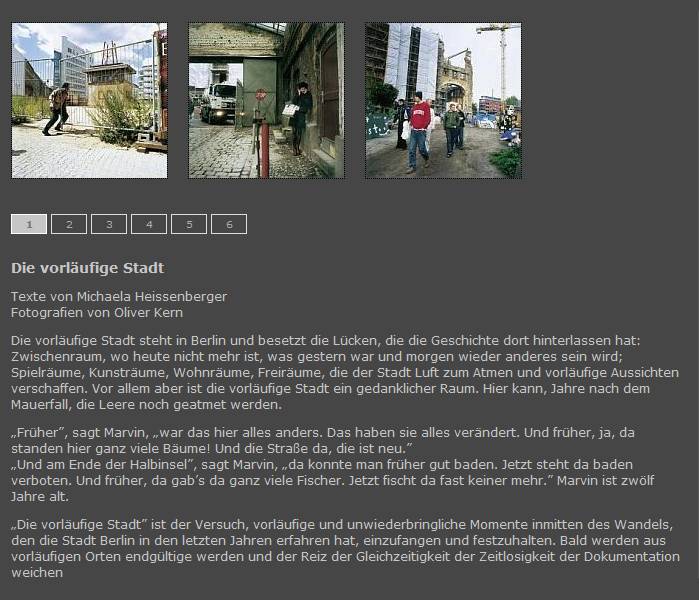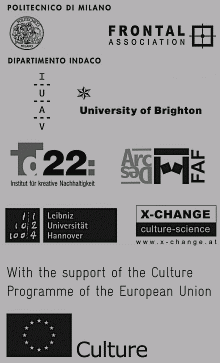The artists perception of the city of...
Oliver Kern / Michaela Heissenberger
BERLIN
The temporary city
The temporary city is a Berlin that does not exist any longer. The photographs and texts by Oliver Kern and Michaela Heissenberger – a small sample of which is presented on the following pages – were created around the turn of the millennium.
www.oliver-kern.com: Die vorläufige Stadt
Island City
“In the past,” says Marvin, “all of this was different. They’ve changed everything.”
He points across the hard sand and the puddles. An icy wind is tearing into us, but on a small mound of scrubs there are three large wooden pallets – upright, weatherworn and grey. “Over there on the right, that was the brewery,” says Marvin. A massive, decoratively ribbed redbrick building, still imposing. “They demolished part of it.
And that road there, that is new.” It is covered in fresh, black tarmac and the streetlights are painted dark blue. The drawn out building with the smashed windows was a glass blowing workshop, where during the Expo 2000 one last exhibition took place. The boy points out the remaining chimney, way in the distance across the derelict site: “There used to be two. They knocked down the other one. And in fact there should be another building there.”
A flock of birds crosses the grey sky. Marvin shouts up: “I know what they’re up to!
They flock together and fly where the water is warmer. And look, the two at the back, they are really weak. Did you know that birds have leaders?”
To our left a green garden gate opens, a man wheels out his pushbike, gets on it and cycles off. It is the last house in Krachtstraße. The tiny garden is as neat as the whole row of pre-war residential blocks, recently renovated and painted pink. The footpath is paved with slabs of concrete, and young trees grow in plant beds covered in bark mulch. An iron park bench is waiting for its first signs of wear. “This yard used to be filthy,” says Marvin. “I used to live here myself, you know, in Number 14. But then we had to move.” Now his family lives at the other end of the terrace, where an empty corner plot meets the peninsula’s main road “Alt-Stralau”. “There used to be a building here, too – you could buy toys there. Now they’re building something.” In the centre of the dug out plot stands a tree on a double plinth: its former stone surround, and the soil that was left around its roots, falling off all around. “There used to be lots of trees here!” says Marvin. A construction site fence surrounds the plot, but some energetic joker has knocked over its concrete feet along the side facing the road, flattening the fence. Above it there is a sign with the logo of “Water City Stralau”, giving notice of the construction of an office and residential complex – “Island City
Berlin”.
A few meters on there is the old entrance to the glass blowing workshop; a locked iron gate with a sign, a warning light and a mirror. The barrier behind it is closed, too, but the wall that used to surround the site is gone. The new road turns off here now, running straight across the wide empty space of the former company grounds to the other end of the peninsula. Through the thick glass of the gatekeeper’s door one can make out two large wooden wall cabinets, time cards still in place. Another 100 metres on there’s a redbrick building, the inscription ZENTRAL BÜRO still just about legible, though several letters are missing. The narrow building is reminiscent of a railway station; the hands of the large clock have stopped at five to twelve. But the window frames have been painted quite recently.
Now and then youths pass us in the street, and young mothers with prams. The new road leads to a residential area. In the distance apartment blocks rise up, all glass and multicoloured balconies. “I think they were built in 1999,” says Marvin, trying to control his dog that is pulling on its leash. Marvin is thin and pale, dark rings under his eyes. “There’s also a shopping mall – that’s changed a lot, too. There didn’t use to be a hairdresser or a travel agent, there wasn’t anything. And only one bus route used to come past here, now there are two.”
“And at the tip of the peninsula,” says Marvin, “there used to be good swimming.
Now there’s a ‘No Swimming’ sign. And in the past, there used to be a lot of fishermen. Now hardly anyone goes fishing there.” Marvin is twelve years old.






